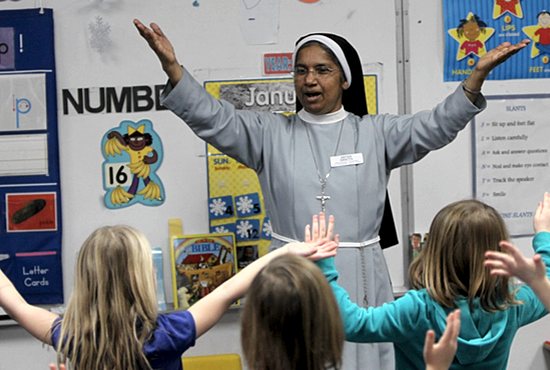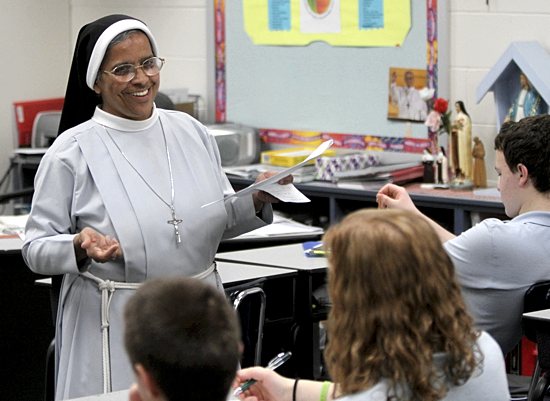Consecrated religious bring gifts to the classroom

Sister Tresa Jose Athickal uses an incorrect answer from a former student to teach eighth-graders at St. Therese School in Deephaven the three vows consecrated men and women take: poverty, chastity and obedience.
“Not obesity,” said Sister Tresa Jose, a Franciscan Clarist Sister from India who has taught at the school for 42 years. “One year, a student mistakenly wrote ‘obesity’ instead of ‘obedience.’ I asked her about her answer in the hall the next day, and she knew the correct one. We had a good laugh about it. And students today remember what the three vows are.”
Christian Brother Michael Rivers at Cretin-Derham Hall in St. Paul — a high school with an enrollment pushing 1,300 — knows about 75 percent of the students by name. What helps, he says, is when students are the children of former students.
“I think the kids enjoy being noticed and appreciated. And many of these kids I don’t have in class, so I have nothing to harass them about,” said Brother Michael, who has been at Cretin-Derham Hall since the early 1980s. “But it’s just the idea that they’re important.”
At St. Croix Catholic in Stillwater, three Dominican Sisters and their principal, Sister Mary Juliana Cox, field questions — verbal and nonverbal — from young students.
Did you know? Throughout history, it has been religious communities of women and men that were at the forefront of the Church’s response to societal ills, especially in the areas of education, health care and social services.
From Sister Cathy Bertrand, School Sister of Notre Dame
Answers range from “No, I’m not Jesus” to “I’m not weird even though I don’t have a cell phone.”
Sister Grace Dominic Hargadon delights in middle schoolers’ animation.
“One day, they came in and said, ‘Sister, can we show you our tango dance?!’ And I’m in religion class, but I said, ‘Yes, yes you can.’ I’m going to delight in you and teach you what that’s like, because that’s how the Lord loves us, he delights in us,” she said.
While the gifts these consecrated religious bring to their schools might differ — a colleague of Brother Michael shared that one of his hidden talents is making balloon animals — what they share is the desire to bring students closer to God.
Often, that’s accomplished through silence and prayer. Sister Magdalena Dudenhoeffer, who teaches fifth grade at St. Croix Catholic, gives her students quiet time to think of Jesus in the tabernacle or reflect on Scripture.
“Some of the greatest joys [of teaching] are those moments when they connect to God, because children have that ability; their souls are so much more capable of connecting to God in a certain way,” Sister Magdalena said. “So just making that effort to give them the chance and watching their relationship with God flourish is so beautiful.”
Brother Michael often sees students expressing their faith through service.
“I believe more of the practical spirituality,” he said. “How do you live the beatitudes, the social justice teachings of the Church? Many of the students may not go to church on Sunday, but when you see them involved with many of the outreach programs, that’s where they experience God and their faith.”

Present, not perfect
Each of the consecrated teachers realize that students need someone’s presence, not perfection.
“We have to know where the kids are, where they come from,” said Sister Tresa Jose, one of four Franciscan Clarists teaching at St. Therese School. “Even family structures affect a person and who they are. As a teacher in the classroom, we have to be a constant, we have to be a friend sometimes. They need to know I care about them.”
Eighth-grader Astrid Liden, also a parishioner at St. Therese, said the sisters make her grateful for everything she has.
“The sisters are very humble, so being around them gives me a sense of peace and tranquility.”
Working with a variety of students in the academic development program he created, Brother Michael can individualize based on students’ needs and situations.
“We have many dedicated staff here, and I admire them having to juggle teacher careers with being a parent,” he said. “But I can just be more present to the students and can spend more time wondering and thinking and praying for them.”
“I think it’s vital there’s that presence of what it means to belong,” said Sister Mary Juliana, who has served as St. Croix Catholic’s principal for four years. “Even with people being so connected through Twitter or Facebook, there’s such a disconnection between people. They don’t know what it means to be part of something, to be part of the Church, to be part of Christ . . . to belong to him. I would hope [the students] would see that in a consecrated soul, the joy that comes from belonging.
“We’re not just [teaching] so the kids can be successful and get a good job,” she continued. “We’re doing this so they get to heaven.”

View of religious life
For the teachers, being immersed in the life of the school means consistently bringing faith, liturgy and lessons about vocations.
“It’s important for the students to see how we interact. That’s part of religious life,” said Sister Mary Margaret Taranto, a second-grade teacher at St. Croix Catholic. “If they just saw me, they wouldn’t see the fullness of my life.”
Sister Magdalena described her role as “spiritual motherhood” — for everyone in the school.
“I have to be a sister teacher,” she said. “They need my consecration. They need me to love them. They need me to have time to talk to them. And . . . it’s not just the kids; sometimes it goes out to the teachers, because they need to be listened to.”
Colleagues say they also bring joy to the school.
Colleen Kane-Rood, a second-grade teacher at St. Therese, considers herself fortunate to have attended a Catholic school and now teach in one with sisters.
“I believe that at a Catholic school, the presence of the sisters brings a faith-filled balance in the school,” she said. “It just feels like more of the Catholic faith is visible.”
For years, Pat Norusis has worked side-by-side with Brother Michael in the Learning Lab at Cretin-Derham Hall. She said his deep faith always emanates to others.
“He gives cards for every occasion,” she said. “The whole community really feels his presence and really cared for by him. Even if he’s a little stern and expects a lot, the students know he wants the best for them.”
Senior Casey Malone-Povolny is one such student.
“I look at Brother Michael as wanting to help people. He doesn’t do it for himself. He does it for others,” he said.
Malone-Povolny continued: “If he can’t do it, he’ll find someone who can. I respect that.”
For more information about religious orders in the Archdiocese of St. Paul and Minneapolis, visit 10000vocations.org.




